What is the building block of marketing? What makes up its core?
If you pry away all the extra stuff you need to know in marketing — the social media calendars, website development, SEO, advertising, just all of it — if you take all that and throw it out, what do you get? If you stripped it clean right to the bone, what is marketing?
We believe marketing is all about relationships.
Relationship Marketing is the process of developing a trusting, long-lasting relationship with your customers. It often includes personalized and tailored messaging that emphasizes a business's sincerity to customers as well as their trustworthiness. Its purpose is to build loyalty over time.
To do this, businesses need to treat each customer like an individual rather than just another number or transaction.
 Relationship Marketing is the future of customer loyalty.
Relationship Marketing is the future of customer loyalty.
Gone are the days when customers would just buy a product and never come back. In today's world, consumers have more choices than ever before. They can go to various websites or social media sites for information about your products, and they can choose not to give you their business if they don't like what they see.
It has become increasingly important for businesses to focus on keeping customers happy with personalized experiences that emphasize trustworthiness and sincerity. Building strong, long-lasting relationships with them.
This blog post will discuss how you can create brand advocates by implementing Relationship Marketing strategies into your existing customer retention strategy!
In this blog, we will explore the following:
- What we mean by “Relationship Marketing”
- The importance of relationships in your branding;
- How Relationship Marketing improves the customer experience;
- The connection with “World of Mouth” marketing, and;
- Practical steps for building relationships through marketing tactics.
“Relationships are the currency of business- they're powerful. They've always been powerful and brands who "get it" will continue to grow” @JessikaPhillips (click to tweet)
Marketing is all about forming and building relationships. Relationships are the currency of business. It seems like a no-brainer, but if you make relationships the focus of your business’s marketing efforts, then you’ll be able to grow and support a mountain of new clients. We’ve called our technique “Relationship Marketing” for quite a while now.
“The best marketing doesn’t feel like marketing," Jessika shared in this podcast from 2018.
(Yep, you read that right. We’ve been passionately raving about this topic for years!)
Let’s look at how you can put those same ideas into practice.
First, how do we define Relationship Marketing?
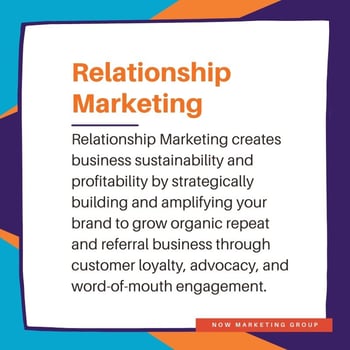 Relationship Marketing is a customer-centric approach to business. It puts the customer first and focuses on building relationships with them. It’s more about what you do for your customers over time instead of what you say in one moment. And it's not just an idea; it's something we have been practicing with our clients, all of whom report increased revenue.
Relationship Marketing is a customer-centric approach to business. It puts the customer first and focuses on building relationships with them. It’s more about what you do for your customers over time instead of what you say in one moment. And it's not just an idea; it's something we have been practicing with our clients, all of whom report increased revenue.
Relationship Marketing isn’t a campaign - to be crystal clear, it’s a mindset. It requires you to rethink how you evaluate marketing success.
Are you building long-term relationships or are you focused on monthly sales quotas?
If you’re doing it right and forming strong connections with people who believe in what you do, the strength of your most successful business relationships will drive the growth you’re looking for.
Consider:
- Repeat customers spend on average 67% per purchase, yet require just 10% of the marketing spend compared to new customers1
- If your retention rate increases by 10%, the average length of customer relationship doubles2
- Fully engaged customers deliver 51% more income than disengaged ones2
- If the retention rate increases a mere 5%, profitability goes up by an unbelievable 25% - 95%3
- 85% of companies admit long-term customer relationships are important to business4
All of this ties into the first step in what we call the CARE process.
- Capture Attention
- Articulate your Message
- Relationships for repeat & referral business
- Exceptional experiences
Through CARE, you’ll start to build lasting relationships with customers who not only use your products but can become your biggest and most raving fans.
Let's explore how Branding and Relationship Marketing go hand in hand.
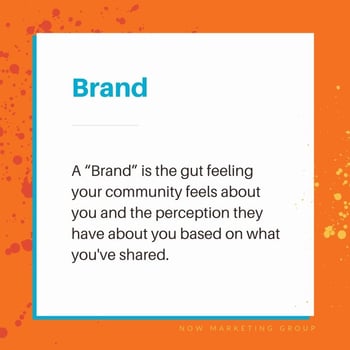 A brand is the personality of the business. It’s not an afterthought slapped together with a few colors and a logo. Rather, a brand is defined by how we make people feel and relate to us.
A brand is the personality of the business. It’s not an afterthought slapped together with a few colors and a logo. Rather, a brand is defined by how we make people feel and relate to us.
This means we all must spend some significant time defining our individual brands. In addition, we need to figure out who we are at our core. Together, this will establish a “Brand Personality” that your ideal audience will love and support.
The key is in establishing a brand personality and its story. It’s about understanding that story and having the ability to communicate it with others. A brand should have a great message about what they do, why it matters to them, and why it matters to us. This allows customers into your world as if they were part of something big.
A brand can be an idea that transcends other parts of marketing.
Need proof? When we say “Apple” or “Whole Foods,” everyone knows exactly who those brands are thanks to their stories.
This means telling your company's story by being crystal clear on WHO you ARE, WHAT you DO, WHY you do it matters.
Even more important is that what we do is all in the HOW we do it.
Relationship Marketing works the same way; it’s about understanding your customers on a detailed level.
Where do they hang out? What do they listen to? Do you know what they care about? How about what drives them?
Without investing in getting to know them, you’ll fail to deliver an exceptional experience that keeps them coming back for more.
In fact, focusing on delivering the best experience possible every single time is the best way to build repeat and referral business. Every time someone does business your company reinforces the brand image in their mind.
This means we need to be able to deliver the best customer experience and build a brand that people are willing to pay for.
Next, it's time to focus on the customer experience.
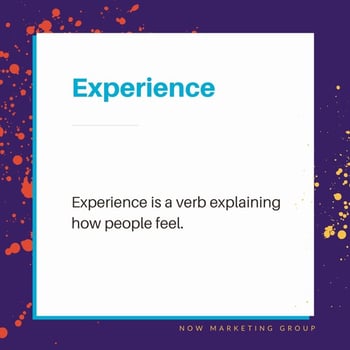 If a brand is how your community perceives you, experience is the natural extension of that. And believe it or not, the #1 deciding factor why someone chooses one business over another is based on one core thing: EXPERIENCE!
If a brand is how your community perceives you, experience is the natural extension of that. And believe it or not, the #1 deciding factor why someone chooses one business over another is based on one core thing: EXPERIENCE!
The successful business owner knows that a customer’s lifetime value and loyalty may well be worth more than the immediate sale. Therefore, relationship building - not just at the point of purchase but over time - has become an essential element in any client-centric strategy.
Relationship Marketing simply means building a relationship-centric customer experience.
People buy from brands they trust. So, when we're building our own brand, we have to remember why customers come back time after time. The most important thing is being authentic in everything you do online.
For example, did you know that 90% of all buying decisions start online? And did you know that 60% of the buyer's journey (aka, the sales decision process) is made up before the customer ever speaks with a sales representative at your company?
This means potential buyers are starting their sales journey on their own. They’re making up their mind based upon what they find online and how it makes them feel.
In everything you do, every brand should be:
- Authentic
- Passionate
- Likable (for your audience)
- Unique
It’s not about what we do, it’s about how we do it. To say it another way, we can literally build a brand experience with a mindset to "out-CARE the competition" and the best way to create a better customer experience is by building a relationship with them.
 A Relationship Marketing approach means that you are going for a share of heart, not just mind or wallet. It’s about creating an emotional connection with both your customers and prospects so they want to be engaged with you in return.
A Relationship Marketing approach means that you are going for a share of heart, not just mind or wallet. It’s about creating an emotional connection with both your customers and prospects so they want to be engaged with you in return.
This isn't a sales funnel approach to sales and marketing. Instead, it's a flywheel, or a circular system focused on building and nurturing relationships.
A flywheel will drive repeat business rather than viewing each transaction as a one-time event.
I’ve said it before, and occasionally get some heat from it, but hear me out. I believe that a customer-centric, flywheel approach like this has effectively killed the traditional sales funnel.
The flywheel model means that our customers are driving our leads for us, sending new business our way through rave reviews and ongoing conversations about us.
In essence, a flywheel grows our businesses through the momentum of repeat and referral business.
I want you to keep this in mind too: you can't be everything to everybody. And guess what? That’s okay. Your message is all about who you are for your ideal customer, not everyone else out there.
We’ve explored the importance of branding in a lot of our other posts. To summarize, a good brand puts less focus on what you do. Instead, it communicates how and why you do it to energize the community of like-minded individuals you are trying to develop.
Consider:
- 91% of customers would switch brands if a different brand of similar price and quality supported a good cause.4
- 90% of consumers welcome brands knowing more about them if they can deliver a better customer experience.5
- When it comes to making a purchase, 64% of people find customer experience more important than price.6
“The best marketing isn’t marketing, it’s relationship building.” @jessikaphillips (click to tweet)

Now, you're ready to reap the benefits of "World of Mouth" marketing.
In the 20th century, word-of-mouth marketing meant that relatively small communities emerged around existing brands. Think the Apple of the ’80s and ’90s: a select, small group of brand loyalists.
In the 21st century, this has transformed into a “world”-of-mouth marketing. How? Digital customers are supplied with more information on products and services than ever before.
 Just think of all the touchpoints we have available at any given moment.
Just think of all the touchpoints we have available at any given moment.
This also means that we as brands must define what makes us stand out from the next option out there so we don’t blend into a sea of sameness.
Using the Apple example once again, there’s a conscious decision why they incorporated the notch into their home screen design. At its launch, it was visually distinctive from other handsets on the market. And oh yeah, it just happens to provide a new technology at the same time, removing the Home button and incorporating FaceID.
Raise your hand if you showed at least one friend or family member how this new feature worked. That’s word-of-mouth advertising.
To Capture attention (the C in CARE), we must define what makes us unique and what we’re really in business to do so that we capture the attention of our ideal audience.
Enter: World of Mouth
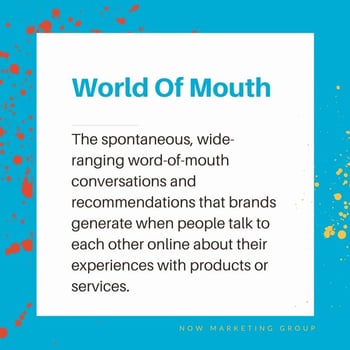 Have you ever shared something on social media that you recently purchased?
Have you ever shared something on social media that you recently purchased?
I know someone who has become a huge cyclist over the past couple of years and has developed a strong loyalty to a specific brand of bikes. He routinely shares his cycling journeys online, whether he’s climbing a mountain bike trail or exploring the countryside.
Do you know what’s front and center of every photo he shares? The bike’s brand.
Everything he shares online, ranging from his experiences to his off-roading adventures, helps build their brand. It makes others want to join the cycling world because they see how much he’s enjoying it.
A message is only as good as the messenger. Your job in Relationship Marketing is to send out great messages at a greater frequency than anyone else by building loyalty.
That same bike brand, when they share content my friend engages with, fuels the fire within him.
Are there other bike brands out there? Sure. But none of them resonate with him because they haven’t earned the trust or reputation in his mind.
My friend respects the other brands and even has done some online research on them. That being said, with all the information out there, world-of-mouth is our best source of information.
In fact—now that we have more data on digital consumer behavior—we know that it’s as important as it’s ever been.
- 61% of customers share their shopping experiences with friends and family members7
- 84% of consumers say the recommendation of a friend or family member is their most trusted source when making a purchase decision8
- 92% of consumers trust recommendations from people they know directly, and anonymous reviewers have a 70% trust rate when they post online9
The fact is: People are mostly influenced by what their peers are saying about brands and businesses. Everything else is more or less noise.
 But now the definition of peers has changed- peers online are seen as others who are like us. We consider reviews online and online discussions about a brand as advice & influence.
But now the definition of peers has changed- peers online are seen as others who are like us. We consider reviews online and online discussions about a brand as advice & influence.
In fact, 83% of people trust online reviews as much as they would reviews given by a trusted friend.
To succeed, you have to be a part of those conversations, and you do that by getting people pumped about why you do what you do. By defining what makes us stand out from the next option out there, we can capture attention.
Finally, let's dive into putting Relationship Marketing into practice
So how do you do Relationship Marketing? Start from the basic foundation which means starting from the inside > out.
 First, dive into the inside of your brand meaning, asking who are you at your core and why the brand exists? Then, ask who you exist for? Finally, to have a true brand, then it must have a distinguishable personality.
First, dive into the inside of your brand meaning, asking who are you at your core and why the brand exists? Then, ask who you exist for? Finally, to have a true brand, then it must have a distinguishable personality.
I mean, think about it, can form a relationship with someone who has zero personality? Of course not!
Every time you interact with them, they’ll feel like a stranger to you. There will be no attraction and definitely no loyalty if you can’t connect with them.
Crafting the brand personality, story, tone & why message is key using these 8 steps.
1. Creating A Brand Manifesto:
To utilize Relationship Marketing, you first have to start at the beginning and examine your “Brand Manifesto.”
If you don’t already have one, your brand manifesto is your declaration of what you're here to do and who you're here to do it for. In other words, it defines your purpose: what you do and why.
With your Brand Manifesto, the goal is to create something that captures the personality of your brand. It also serves as a guide to how you appear to others both in-person and online. Plus, it keeps you connected to the bigger picture, the heart, and the personality that your ideal audience is looking for.
The Brand Manifesto includes your core values and how you want to be known in the world. It’s a declaration of what sets us apart from our competitors.
When developing your Brand Manifesto, ask yourself “What is it that makes my product or service different from all others?” The answer should then become who we are as an organization; not just a singular message about your products or services.
Every Brand Manifesto should include:
- Core Values: What is important to the organization as a whole;
- Vision for the company and future employees, clients, partners, and stakeholders of where we are headed in the world;
- Defining what it means to be a member of the team, and;
- The mission statement or purpose behind why the organization exists.
A well-defined Brand Manifesto ties all of these together and places your customer at the center. If your manifesto acts as a declaration call to those looking for it, you know you’ve done it right.
Once you write your manifesto, now it's time to identify your brand advocates -- aka, Buyer Personas.
With your brand manifesto declared, you can now start identifying those that are most interested in helping you push your business forward, or your brand advocates.
2. Identify Brand Advocates:
To find your brand advocates, you need to locate the people that are interested in engaging with your business in a meaningful way. These can be your current customers, your team members, your business networks, or your social followers that frequently connect with what your business is doing.
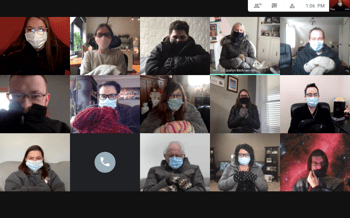 Rank your list of customer segments into tiers. Tier One customers are the most loyal, the ones who you know will always buy from you. Tier Three are people that would never purchase anything from you, and Tier Two's can be considered a mixture of both.
Rank your list of customer segments into tiers. Tier One customers are the most loyal, the ones who you know will always buy from you. Tier Three are people that would never purchase anything from you, and Tier Two's can be considered a mixture of both.
P.S.: Don’t be fooled by the people who just like your page. Instead, try to find those who share your content and engage with it. Or if you’re creating content, identify your like-minded collaborators who show up to do the work.
Once we identify these “personas” we now need to describe them as if we're describing a friend.
The goal is to find those that already live and breathe your message.
Another set of often overlooked advocates involved in your business are your employees. If you consider your brand manifesto when making hiring decisions, you should likewise be hiring employees that match your business’s overall goals.
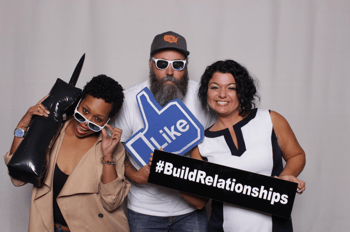 Once we identify our biggest advocates, we can turn them into true fans by cultivating relationships with them and creating a larger sense of community around a shared purpose.
Once we identify our biggest advocates, we can turn them into true fans by cultivating relationships with them and creating a larger sense of community around a shared purpose.
3. Develop A Sense Of Community:
From the start — that is, if you already have Relationship Marketing as your guiding principle — you should be on your way toward creating a community. At this point, don’t focus on pushing people toward sales. Instead, you want your relationships to form more naturally over a shared purpose, which is driven by your brand manifesto.
There are two primary ways brands can build community:
First, Use Content to Connect
The first step toward creating a larger community is connecting with people through your content. On your website and blog, you should be answering questions that people have asked you in the past. On social media, you’ll want to share content that encourages people to engage.
Ultimately, your goal is to use these content opportunities to take note of the people that are taking note of you. Then, respond back to them in a way that lets them know that you both see and appreciate them. It’s like starting a conversation and identifying people who are most interested in the points you’re making.
Second, Focus on Personalization
The best way to show your appreciation is one-to-one personalization. For example, if you get a response back from someone after you post content, you’ll want to message them back. At the very least, comment back in a way that asks a follow-up question so that you can continue the conversation.
This community-building applies just as much to your current relationships as well as those you’re trying to cultivate a relationship with. If you’ve earned someone’s business, send them a card or video email. Be sure to personalize it just a little bit to start that relationship off on the right foot.
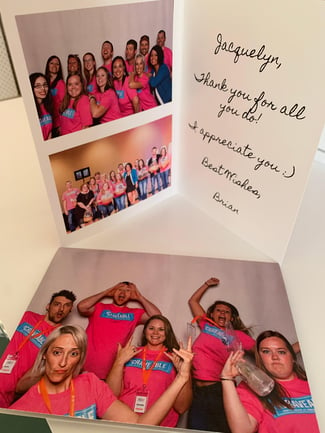 Whatever your approach, it’s about standing out from the crowd by showing a focused interest in one-on-one engagement.
Whatever your approach, it’s about standing out from the crowd by showing a focused interest in one-on-one engagement.
4. Utilize Buyer Personas:
From the very beginning, when you're working on the inside-out approach, you must understand and know your personas.
Some people call them Buyer Personas. Some people call them avatars. Whatever terminology you use, they're the individuals you're truly there to talk to.
In other words, who do you want to have a conversation with before you even start the conversation? Who is your website copy aimed at? Are your social posts targeted to their interests? Do you have a picture in your mind of the type of user who will watch your videos?
It boils down to this: who are you truly trying to build that relationship with?
Only once you have that understanding can you show up authentically to start building a relationship with that Buyer Persona. Likewise, because the message is tailored to them, those same people will be drawn to you.
Inversely, knowing your Buyer Persona also helps inform the conversation on who you're not there for. This can actually be super helpful for brands because it helps you quickly identify the individuals that don’t provide the services they’re looking for, or, you’ll simply never be able to make them happy.
5. Earn Cultural Credit
Eventually, you’ll start to build cultural credit from the people that love working with you and love what you’re doing. This includes helping others of a similar mindset connect with each other. Even if it’s between people who haven’t worked with you yet, you can still forge connections that help you gain cultural credit, which can lead to more business in the future.
An example of this may be helping the people who are still paying attention to what you are doing, but they may not be buying your service or product.
Take marketing professionals as an example. NOW Marketing Group provides free training and videos for other marketing professionals as part of our larger Relationship Marketing strategy.
Because we’ve established our Buyer Personas, we already know that marketing professionals who visit our website are not trying to hire a marketing company. However, we do know that they’re talking about us all the time.
So, if we create those experiences and tools geared to marketing professionals, we'll be building these great relationships, which in turn lead to even more networked conversations down the line.
 Other ways to build cultural credit are by offering additional free resources on your website or by encouraging community engagement, such as through social media posts online. The key, as Bella Vasta says is to “Be the destination”.
Other ways to build cultural credit are by offering additional free resources on your website or by encouraging community engagement, such as through social media posts online. The key, as Bella Vasta says is to “Be the destination”.
What does she mean exactly? You want to be the destination to offer value to your community and to treat them like the VIPs they are. Invest in the people who enjoy working with you. This will not only ensure these clients stick with you but they become even more of an advocate for your brand. It also encourages those who are curious about your business to want to be part of the experience you’re providing.
Facebook, LinkedIn, and Twitter all have slightly different ways of hosting discussions. However, they all share similar messaging functionalities that encourage community conversations. These platforms can also be tied into event planning to increase the levels of engagement with what you’re doing and encourage everyone to take a more active part in the conversation. Over time, such focused energy creates ripples.
Regardless of the social platform, it’s about providing value to the audience.
6. Pump The Referral Motor:
Once you align all the pieces that define Relationship Marketing, you can begin concentrating on making the system work for you. In NOW Marketing’s case, clients consistently refer us to work with others in their networks, and we’ve cultivated a sustainable and profitable momentum of growth because we're not doing the grunt work of getting more leads in the door. That part is already being worked out for us by our advocates.
Due to our past work, our advocates are already willing to help us and share our content because they know it was created specifically for them. If you build the growth momentum through the power of relationships, some of your marketing work is already being completed.
7. Stick To It:
While some brands have tried to utilize Relationship Marketing in the past, they may not see the same results because they haven’t fully committed to the process.
It’s true that many businesses have to be focused on sales to survive. But if a business has started at the brand manifesto and worked their way up, they should naturally be building a Relationship Marketing foundation as a consequence of reframing their business.
Marketers overthink the process sometimes. Instead, just concentrate on answering the questions your best customers would be asking: What do they want to read? What do they want to see? How do they want to be treated?
Answer those questions and then find every opportunity to communicate those answers.
8. Remember To Focus On Great Experiences:
As we mentioned, more than 90% of all buying decisions start online and 60% complete the process before ever engaging with a business. This is all done via social media and digital world-of-mouth.
Remember, whether our customers choose this service over another is often being decided without us knowing every interaction.
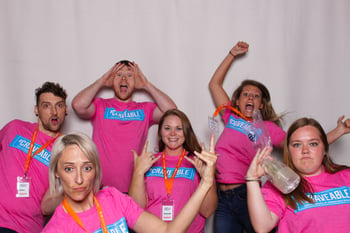 So when a potential customer does start engaging directly with your business, you better be ready to make every touchpoint count.
So when a potential customer does start engaging directly with your business, you better be ready to make every touchpoint count.
Do you know what it looks like to buy or learn about your service or product? Do you emphasize speed, ease of use, and accessibility when people work with you?
And when you respond to something, are you doing so in a way that is adding more value than what the person on the other end is putting in?
To ensure a painless process for potential customers, we recommend clients write out their full sales process onboarding process and look for opportunities to reduce friction and add delight.
Just think about some of the opportunities other businesses overlook because they’re not thinking about Relationship Marketing.
If someone is receiving ads, do we know how the ads are showing up in every area he or she is interested in? How can we add and enhance what we're doing to give more access to us as a brand? Can you give customers more control of how they can navigate working with you?
If you can imagine yourself along for the ride during the customer journey, that can help the process. But also, if you just live in the world of your customers and try to be one of them, you're going to start developing bonds and have a better understanding of the problems you can help them solve.
Ask yourself: How do you embed yourself in the world of your clients and be a part of their community to see how it changes? What do they need? What can you do to make it easier for them?
Once you can answer those questions, you can apply those lessons and add further value to your customer’s buying decision.
Use Relationship Marketing To Grow Your Business!
With the points we covered today, you’re well on your way to getting started on figuring out what you need to do to make Relationship Marketing work for you.
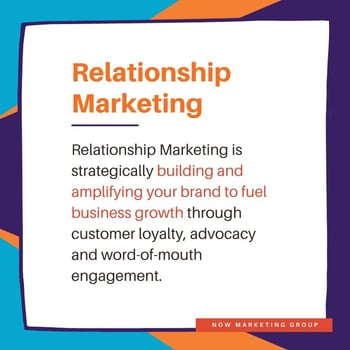 Your goal should be to shift your marketing away from marketing that prioritizes sales. Rather, focus on building relationships through focused branding, community development, and long-lasting brand advocates who can help you grow through word-of-mouth which is now World of Mouth.
Your goal should be to shift your marketing away from marketing that prioritizes sales. Rather, focus on building relationships through focused branding, community development, and long-lasting brand advocates who can help you grow through word-of-mouth which is now World of Mouth.
Building sustainable earned and organic business growth is all about creating experiences that at its core are all about relationships ROI.
Relationships will always be more powerful than marketing.
Now that we’ve discussed the foundation of what creates and separates great brands vs. short-term sales, it’s time to dive in so you too and reap the rewards of doing what’s right, not what seems easy in business.
So, if you’re ready to build a fully developed brand manifesto along with defined Buyer Personas, with tailored messaging and communication that connects your brand story both off and online- then these techniques, including content development and personalized one-to-one dialogue, will allow you to develop the crucial relationships your business needs to succeed, supercharging its growth for years to come.
Just remember, Relationship marketing isn’t a campaign, it’s a commitment.
Putting all of this all together takes time and a concentrated effort because the loyalty of your community isn’t something for sale. Below you’ll find our Relationship Marketing Guide and workbook to get you started and a group of peers that can help you along the way.
If you may find yourself in need of help and guidance simply getting started or even rolling out your Relationship Marketing mindset within your organization. If that sounds like you, we’re here to help! Contact us today and we’ll schedule a time to chat, go over your business goals, and show you how Relationship Marketing can help completely transform your company.
Data Sources and Additional Resources:
- Patel, Neil. “How To Make More Money Without Making More Sales.” Forbes, Forbes Magazine, 17 Nov. 2014, www.forbes.com/sites/neilpatel/2014/11/17/how-to-make-more-money-without-making-more-sales/?sh=4498bbaf23aa.
- Buchanan, Robin W. T. & Gillies, Crawford S., 1990. "Value managed relationships: The key to customer retention and profitability," European Management Journal, Elsevier, vol. 8(4), pages 523-526, December.
- Forsey, Caroline. “The Ultimate Guide to Relationship Marketing.” HubSpot Blog, 8 Oct. 2020, blog.hubspot.com/marketing/relationship-marketing.
- SuperOffice. Relationship Marketing: 3 Ways to Create Lifelong Customers, 24 Mar. 2021, www.superoffice.com/blog/relationship-marketing/.
- “Study: Online Shoppers Desire Personalization, But Demand Privacy.” Episerver, 24 Feb. 2020, www.episerver.com/company/press-room/study-online-shoppers-desire-personalization-but-demand-privacy.
- Sorofman, Jake. “Gartner Survey Finds Importance of Customer Experience on the Rise - Marketing Is on the Hook.” Gartner, 29 Sept. 2014, www.gartner.com/en/documents/2857722/gartner-survey-finds-importance-of-customer-experience-o.
- Autry, Ashley. “Loyalty Statistics: The Ultimate Collection.” Access Development Loyalty Blog, blog.accessdevelopment.com/the-ultimate-collection-of-loyalty-statistics.
- “Recommendations From Friends Remain Most Credible Form of Advertising Among Consumers; Branded Websites Are the Second-Highest-Rated Form.” Nielsen, www.nielsen.com/us/en/press-releases/2015/recommendations-from-friends-remain-most-credible-form-of-advertising/.
- Kapadia, Amity. “40+ Word-of-Mouth Marketing Statistics That You Should Know.” Referral Marketing Software by Ambassador, 13 Dec. 2018, www.getambassador.com/blog/word-of-mouth-marketing-statistics.
- Buchanan, Robin W. T. & Gillies, Crawford S., 1990. "Value managed relationships: The key to customer retention and profitability," European Management Journal, Elsevier, vol. 8(4), pages 523-526, December.

-1.jpg)
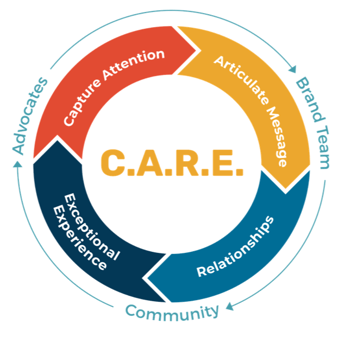
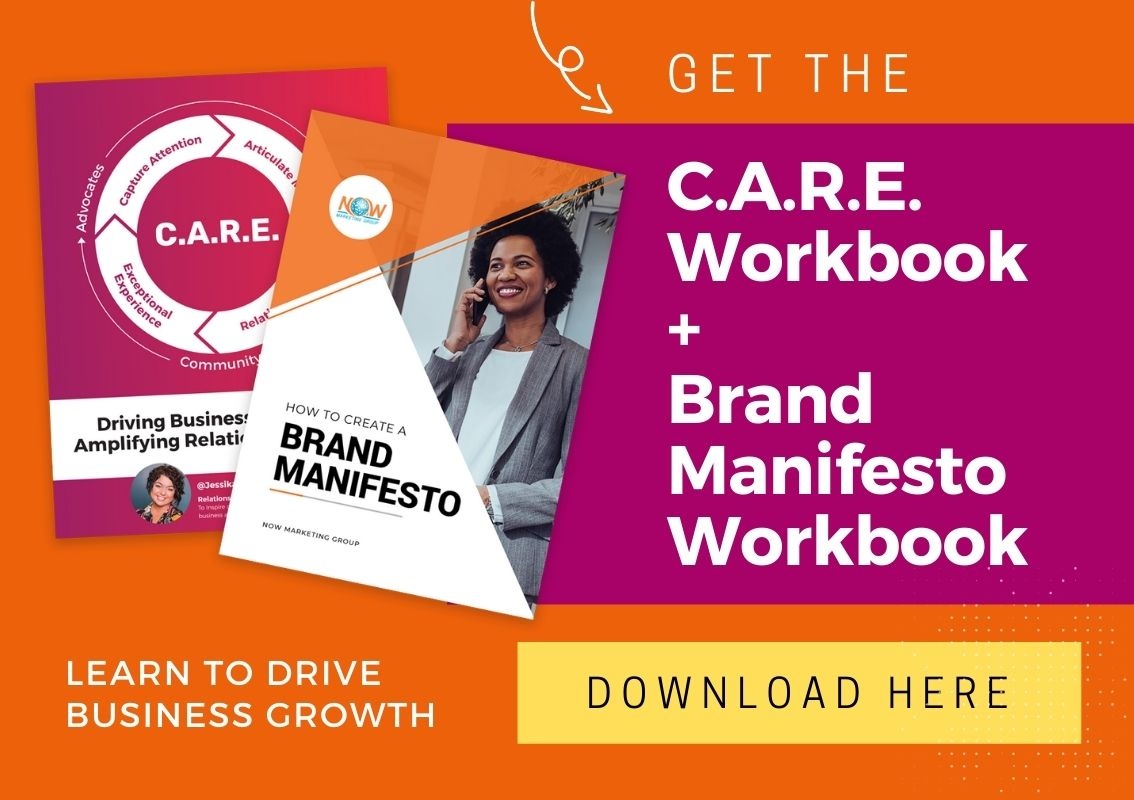
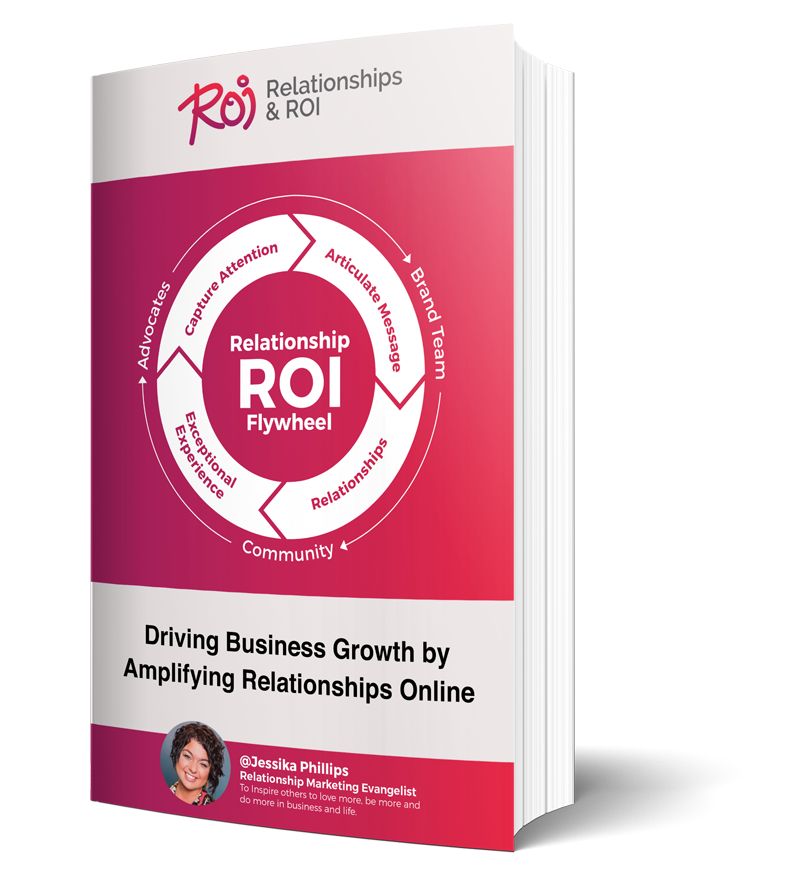
Comments